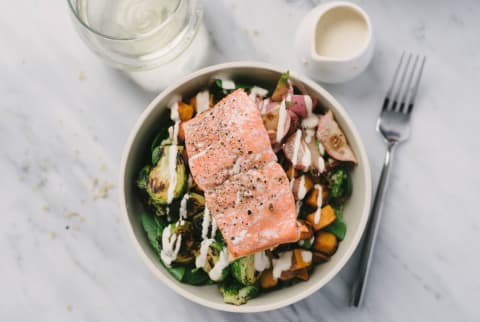What Are The SMASH Fish & How Do You Eat Sustainable Seafood?


Fish can be an incredible food for your health and well-being. It's nutrient-dense, protein-rich, and lots are full of heart-healthy omega-3s. But there are some issues surrounding the fish industry too, from pollution to overfishing, not to mention the elevated mercury levels seen in some diets high in fish.
So when mbg Collective member and functional medicine doctor Mark Hyman, M.D., sat down with mbg co-CEO Jason Wachob, we got his take on the topic. And from SMASH to sustainability, Hyman was sure to share his tips for the conscious consumption of fish.
"There's half a billion people that depend on fish and seafood for their health and their food," he says. "We've overfished the oceans, and specifically certain populations. And so we have to be very careful about what we're eating."
First off: What's SMASH?
When it comes to eating fish, one of the big keys to keep in mind, according to Hyman, is mercury. Specifically, avoiding it. "You want to stay away from the big fish," he says.
The further up the food chain you get, the higher the levels of mercury seen in bigger fish. That said, Hyman recommends "SMASH" or salmon, mackerel, anchovies, herring, and sardines. Because while they may not be your favorite fish taste-wise, they're your safest bet to avoid toxins and metals.
Hyman says he'll often go for small, wild salmon, adding, "I love Vital Choice, which is a really great operation where they go to Alaska and they get the smaller fish. They're not full of toxins, they're more nutrient-dense, and you see the color of these fish. They're bright orange, dark, dark orange. And that comes from all the algae and the plankton they're eating."
Sustainable seafood solutions.
On top of avoiding mercury, another thing Hyman wants us to consider is how sustainably the fish we're eating were harvested. "What are the safe fish to eat? Clean fish? What are the sustainably raised or harvested fish?" he poses. Guides are available online, like this Seafood Watch Guide by the Monterey Bay Aquarium, to help you figure out just that.
Hyman also hopes to see more improvements in the way fish are raised: "I think that the fish consumption in a perfect world would be our main source of protein," he says, "but we need to have innovative ways of aquaculture. There's an incredible place called Veta La Palma in Spain [...] They restored this estuary [and] life came back. It was completely clean, the fish had no toxins, no pesticides, high levels of omega-3s...flamingos would fly 150 miles just to eat the fish there. And there are so many degraded wetlands and degraded estuaries around the world that we can restore these back into fish farms."
We're big fans of SMASH and sustainability here at mbg, so we can definitely get down with these tips. With any luck, more innovations in aquaculture will lend us cleaner, more sustainable fish in the future. And until then, SMASH is a good rule of thumb to get your protein and omega-3s from fish while limiting the mercury.

Sarah Regan is a Spirituality & Relationships Editor, a registered yoga instructor, and an avid astrologer and tarot reader. She received her bachelor's in broadcasting and mass communication from State University of New York at Oswego, and lives in Buffalo, New York.